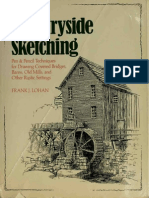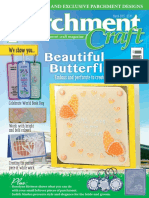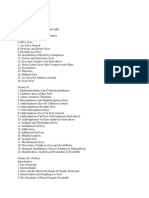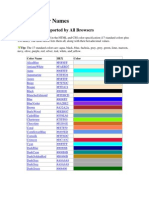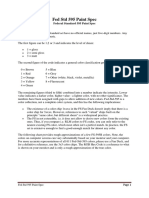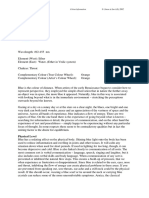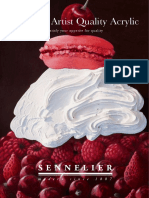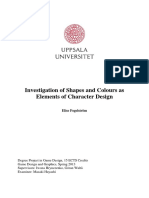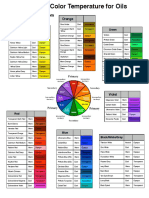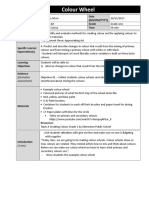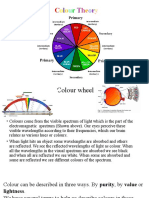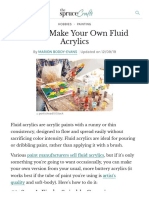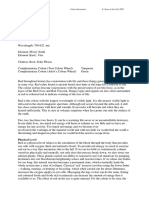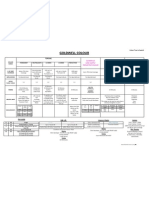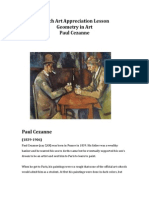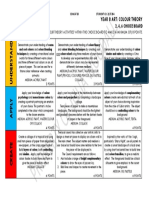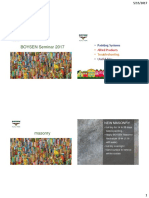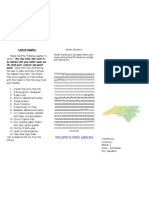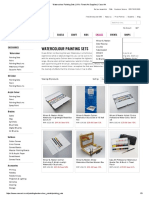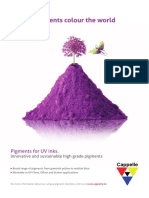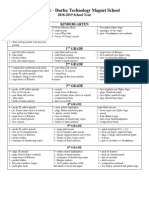Colour Properties and Colour Theory When Painting
Colour Properties and Colour Theory When Painting
Uploaded by
Amalia CandiaCopyright:
Available Formats
Colour Properties and Colour Theory When Painting
Colour Properties and Colour Theory When Painting
Uploaded by
Amalia CandiaCopyright
Available Formats
Share this document
Did you find this document useful?
Is this content inappropriate?
Copyright:
Available Formats
Colour Properties and Colour Theory When Painting
Colour Properties and Colour Theory When Painting
Uploaded by
Amalia CandiaCopyright:
Available Formats
08/05/12
Colour properties and colour theory when painting
COLOUR PROPERTIES
HOME ZEST-IT OILS
TOLE
PAINT
COLOUR
LINKS
COLOUR
Colour properties and colour theory when painting. When the sun shines and it's raining we see a rainbow, the basic colours of which are - Red, Orange, Yellow, Green, Blue, Indigo and Violet (natures' palette). Traditionally, for convenience, these colours are arranged in a circle of six colours (Indigo is not used), to form a colour circle or 'Colour Wheel'. Leaving aside the physical attributes of the paint, we need to look at its colour properties, in order to help us sort out colour for our painting. When we talk of colour for our paintings we usually usethe following terms - warm or cool, light or dark, bright or dull, strong or weak, contrasting or complementary. This in itself tells us something - in painting we are often looking for, 'an opposite, compared to another,' be it temperature, tone, strength, etc., this equals contrast. Contrast in some form, is usually what make a painting 'speak'. Let's start by looking at some of the properties concerned with colour. The paint colour has a name to identify it, often referred to, as its Hue or Colour, i.e. red, yellow, blue. Red, Yellow and Blue are referred to as the Primary colours.
Colours can be warm (red, orange, yellow) the overall feeling of the picture is warm
or cool ( green, blue, violet) the overall feeling of the picture is cool
this is referred to as the Temperature of the painting. This of course is also relative to the colour, you are judging each colour against, in your work. Each colour has a Complementary colour - that it's opposite colour on the colour wheel, e.g. yellow (warm) is opposite violet (cool), red (warm) is opposite green (cool) and blue (cool) is opposite orange (warm). When two complementary colours are placed side by side they contrast with each other, the colours complement each other and seem to be more vibrant. Two complementary colours when mixed together form a greyed or Neutral colour. It also has a Value or Tone, which is its apparent lightness or darkness in relation to another colour. Purple is darker than white and is said to have a lower value. Yellow is lighter than black and is said to have a higher value. Chroma, Intensity or Saturation are words, that are often used, to indicate the brightness or dullness of the colour, you can have a bright or dull colour with the same intensity. This can all seem very confusing, but these properties apply to colour whatever the media used. If you are having trouble with these properties, it could be a good idea to start with the Hue, Temperature and the Complementary properties first, then move on to Contrast, Value and Chroma. It's much easier to take it stage by stage, than to try it all in one go. Traditionally the six colours have been divided into the three 'primary' colours - Red, Yellow, and Blue, and three 'secondary' colours - Orange, Green, and Violet. 'Secondary' because, by mixing two primary colours together they make another colour, classed as second in order. Mixing a 'primary' and a 'secondary' colour together makes yet www.zest-it.com/colour.htm
1/3
08/05/12
Colour properties and colour theory when painting
make another colour, classed as second in order. Mixing a 'primary' and a 'secondary' colour together makes yet another colour, a 'tertiary' colour, third in order, and so on. This only works if you use a paint colour that is bias towards the colour being made, i.e., to make violet you would need to use a red that is 'inclined' towards violet, and a blue that is 'inclined' towards violet. Using a red or blue with a different 'leaning' will not result in a clear, clean violet. Therefore to mix the three secondary colours you would need six tubes of paint; two yellows, two reds and two blues. The names of the colours you could use from, for example, the LaFrance range: Japanese Red Deep as the orange red; Ruby Red as the violet red; Prussian Blue as the green blue; Ultramarine Deep as the violet blue; Flanders Yellow as the green yellow and Sarah Yellow as the orange yellow. These are only suggested colours, try others to find what suits you. For an insight into Colour mixing using the Lefranc range. As artists, it is perhaps better to work with the six main colours as having equal importance as far as colour mixing is concerned. Understanding the principals and properties of colour, helps us to decide what colour is to be used to express our feelings for the subject we are painting. Suggestion - take two primary colours, yellow and blue for example and make yourself a chart. By mixing the colours together yourself you will learn far more than by reading about colour mixing. Learn as much as you can, then put it into practice, this consolidates the learning. Copyright Jacqui Blackman 1999
Hoteles en San Pablo Pague en el Hotel! Solo en Despegar.com Reserve Aqu. Despegar.com.ar/San-Pablo Learn to Paint Comprehensive structured self-study course for serious artists www.VirtualArtAcademy.com Solomon Colors The World Leader in Concrete Coloring Solutions www.solomoncolors.com
HOME | AWARDS | BRUSH CLEANING | BRUSHES FOR OILS | COLOUR | COLOUR MIXING | COLOUR MIXING EXTRA | COLOUR WHEEL | COLOUR PENCIL BLENDING | EASELS | FAQ | FLOWER GALLERY | GUEST BOOK | GALLERY OF FLOWERS | KNIVES PAINTING AND PALETTE | J B GALLERY'S | LINKS | NEWS | OILS | OIL PASTELS | OTHER MEDIA | ONE STROKE BRUSHES | PAINT | PALETTES | PARCHMENT BLENDING | PARCHMENT CRAFT | PRIVACY | PRODUCTS | PROJECTS | REVIEWS | SEARCH | STOCKIST UK | STOCKIST OUTSIDE UK | TECHNIQUE | TESTIMONIALS | TOLE | TOLE BRUSH STROKES | TOLE GALLERY | TONAL VALUE | TUITION | WET ON WET OIL PAINTING | VIDEO | ZEST-IT | ZEST-IT PRODUCT INFORMATION PRODUCTS NEW PRODUCTS | SOLVENT | WASHAWAY | DIP PEN NIB CLEANER | LEAN PAINTING MEDIUM | GLAZING MEDIUM | LINSEED STAND OIL | WAX MEDIUM |
www.zest-it.com/colour.htm
2/3
08/05/12
Colour properties and colour theory when painting
Copyright 1999 - 2012 J. & T. Blackman Ltd. All Rights Reserved Worldwide. The information contained herein is the Intellectual Property of Jacqui Blackman and J. & T. Blackman Ltd., and is supplied without liability for errors or omissions. Zest-it and its logo are Registered Trademarks. No part may be reproduced or used except as authorized by contract or other written permission, unless stated otherwise. The copyright and the foregoing restriction on reproduction and use extend to all media in which the information may be embodied.
www.zest-it.com/colour.htm
3/3
You might also like
- Bela 3DDocument2 pagesBela 3DKaren Reimer80% (10)
- Paper Mill in IndiaDocument5 pagesPaper Mill in Indiapawan_mishra8183% (6)
- SketchingDocument276 pagesSketchingmr mxyzptlk93% (73)
- Wrestling In-SeasonDocument8 pagesWrestling In-SeasonBenNo ratings yet
- Parchment Craft Magazine March 2015Document48 pagesParchment Craft Magazine March 2015asturene100% (1)
- Supply List 2023-2024Document4 pagesSupply List 2023-2024Jon KnoedlerNo ratings yet
- Flower Shops in UAEDocument8 pagesFlower Shops in UAEkassim seoNo ratings yet
- Color MatchDocument3 pagesColor MatchMonalisa VasileNo ratings yet
- Briggs Breakout DimensionsOfColour PDFDocument15 pagesBriggs Breakout DimensionsOfColour PDFDesiré Angelica GANo ratings yet
- Chemistry of Synthetic Dyes, 8 Volumes SetDocument2 pagesChemistry of Synthetic Dyes, 8 Volumes SetDinesh22No ratings yet
- Colors Hexadecimal ValuesDocument5 pagesColors Hexadecimal ValuesVijai RagavNo ratings yet
- Fed STD 595 Paint SpecDocument22 pagesFed STD 595 Paint SpecWawan BudiantoNo ratings yet
- Oil Color Chart Exercises For Artists (Master Your Paint Pallette)Document1 pageOil Color Chart Exercises For Artists (Master Your Paint Pallette)Mohamed Abou El hassanNo ratings yet
- Mcs Courses Colour Information © Simon & Sue Lilly 2002Document1 pageMcs Courses Colour Information © Simon & Sue Lilly 2002Niki MavrakiNo ratings yet
- Acrylic Painting Material ListDocument3 pagesAcrylic Painting Material ListDuraisamy PanchatcharamNo ratings yet
- Colour PinkDocument2 pagesColour PinkNiki MavrakiNo ratings yet
- Lesson Plan For Basic Art ClassDocument11 pagesLesson Plan For Basic Art ClasstiggmanjeNo ratings yet
- What Is Colour Theory in FilmDocument7 pagesWhat Is Colour Theory in FilmGraphite Box StudioNo ratings yet
- 007 Working With Tone - Exercise FileDocument4 pages007 Working With Tone - Exercise FileSagar ThoratNo ratings yet
- Mcs Courses Colour Information © Simon & Sue Lilly 2002Document2 pagesMcs Courses Colour Information © Simon & Sue Lilly 2002Niki MavrakiNo ratings yet
- ColourDocument10 pagesColourthảo100% (1)
- Acrilico Acrylic AcryliqueDocument16 pagesAcrilico Acrylic Acryliqueana salNo ratings yet
- 2color TheoryDocument23 pages2color TheoryPEIN GAMINGNo ratings yet
- Investigation of Shapes and Colours AsDocument41 pagesInvestigation of Shapes and Colours AsAiko AogiriNo ratings yet
- Hunter Lab PDFDocument4 pagesHunter Lab PDFShyam Sundar SahooNo ratings yet
- The Dimensions of ColourDocument13 pagesThe Dimensions of ColourDavid Perez SattdNo ratings yet
- Colour Order SystemsDocument9 pagesColour Order SystemsvimalNo ratings yet
- True ColorsDocument14 pagesTrue Colorsapi-266522578No ratings yet
- Color SchemesDocument14 pagesColor SchemessanndhyaNo ratings yet
- Color Charts - Harji 2Document22 pagesColor Charts - Harji 2trexie ann villacora100% (1)
- List of Colors - A-F - Wikipedia, The Free EncyclopediaDocument18 pagesList of Colors - A-F - Wikipedia, The Free EncyclopediaRohan KapilNo ratings yet
- Several Types of Colored PencilsDocument2 pagesSeveral Types of Colored PencilsseanNo ratings yet
- Colors DocDocument12 pagesColors DocTeorija PajaclukaNo ratings yet
- My ColorsDocument109 pagesMy ColorsPherlouieMoya100% (1)
- ITST 306 - Lesson 1 - Elements and Principles of DesignDocument78 pagesITST 306 - Lesson 1 - Elements and Principles of DesignKatkatNo ratings yet
- ColortheoryDocument2 pagesColortheoryEric BettrosNo ratings yet
- Colours IntroductionDocument121 pagesColours IntroductionDeepak KumarNo ratings yet
- Colour Wheel: Teacher Name Date (DD/MM/YYYY) 24/11/2017 Subject Area Grade Topic Time General Learner Expectation(s)Document3 pagesColour Wheel: Teacher Name Date (DD/MM/YYYY) 24/11/2017 Subject Area Grade Topic Time General Learner Expectation(s)api-352928605No ratings yet
- Continuation of Colour TheoryDocument9 pagesContinuation of Colour Theoryapi-335210893No ratings yet
- Colour Theory PowerpointDocument10 pagesColour Theory Powerpointapi-335210893No ratings yet
- Color TheoryDocument12 pagesColor Theoryheygirlhey100% (1)
- Mixing Colors: Water, Oil Paints or Printing InksDocument88 pagesMixing Colors: Water, Oil Paints or Printing InksArquitecto Angeles100% (1)
- How To Make Your Own Fluid AcrylicsDocument19 pagesHow To Make Your Own Fluid Acrylicsernettopj100% (1)
- Color Theory PDFDocument9 pagesColor Theory PDFFlorin100% (1)
- The Science of ColorDocument12 pagesThe Science of ColorrzbcNo ratings yet
- Color PsychologyDocument3 pagesColor PsychologyRaven SynthxNo ratings yet
- AP ArtDocument9 pagesAP ArtRyan100% (1)
- Colour RedDocument3 pagesColour RedNiki MavrakiNo ratings yet
- Additive vs. Subtractive ColorDocument5 pagesAdditive vs. Subtractive Colorjoshua padsNo ratings yet
- Final Colors TheoryDocument31 pagesFinal Colors Theorypratima1823100% (2)
- My Elements and Principles ColourDocument57 pagesMy Elements and Principles ColourdrhiggleNo ratings yet
- Goldwell ColourDocument1 pageGoldwell ColourMichelle MurphyNo ratings yet
- Color Basics, Color Identification System and Color SchemesDocument4 pagesColor Basics, Color Identification System and Color Schemesmoon starNo ratings yet
- Geometry in Art, LessonDocument6 pagesGeometry in Art, LessonHipsipilasNo ratings yet
- COLORSDocument74 pagesCOLORSMamtha KBNo ratings yet
- Copic Catalog WebDocument25 pagesCopic Catalog Webjeanm87No ratings yet
- Langridge Pigment RRPDocument5 pagesLangridge Pigment RRPstlukeartNo ratings yet
- POLYCHROMOS Artist Color PencilsDocument1 pagePOLYCHROMOS Artist Color PencilsTatiianaAlcantara100% (1)
- Colour and Texture: Visual ArtsDocument35 pagesColour and Texture: Visual ArtszainquaziNo ratings yet
- Where Does Color Come FromDocument7 pagesWhere Does Color Come FromMaria Rhodora Caputolan CapinNo ratings yet
- Computer Vision: Spring 2006 15-385,-685 Instructor: S. Narasimhan Wean 5403 T-R 3:00pm - 4:20pmDocument25 pagesComputer Vision: Spring 2006 15-385,-685 Instructor: S. Narasimhan Wean 5403 T-R 3:00pm - 4:20pmshailendrachimadeNo ratings yet
- Seven Color Contrasts 2013Document9 pagesSeven Color Contrasts 2013Veronica MarianNo ratings yet
- Language and ColourDocument5 pagesLanguage and ColourPetreMerabishviliNo ratings yet
- Color Theory: Slimmer Style,. JSCDocument13 pagesColor Theory: Slimmer Style,. JSCChasity WrightNo ratings yet
- ANSI COLOR 2006-Catalog PDFDocument4 pagesANSI COLOR 2006-Catalog PDFJose Gregorio SanchezNo ratings yet
- Art - Choice Board Year 8 - Colour TheoryDocument1 pageArt - Choice Board Year 8 - Colour Theoryapi-375997249No ratings yet
- ArtistsNetwork ColorTheory 2015Document14 pagesArtistsNetwork ColorTheory 2015oviflor100% (2)
- Intro. To PaintingDocument46 pagesIntro. To PaintingIanMonisNo ratings yet
- 7677 Version 7thDocument2 pages7677 Version 7thDuc NguyenNo ratings yet
- Liquitex Color Chart Heavy BodyDocument2 pagesLiquitex Color Chart Heavy BodyaleNo ratings yet
- K1 Price List 2018 Update 22 September Kirim Cabang Fix PDFDocument4 pagesK1 Price List 2018 Update 22 September Kirim Cabang Fix PDFbodhi CittaNo ratings yet
- Boysen Presentation 2017Document22 pagesBoysen Presentation 2017jhecy100% (1)
- 500+ Named Colours With RGB and Hex ValuesDocument12 pages500+ Named Colours With RGB and Hex ValuesNieyra AmearNo ratings yet
- Social Studies Project .Document1 pageSocial Studies Project .blowfishbillioniareNo ratings yet
- Home A318kdqwfyfs Public HTML Tarek Books Eng Dyes Colors Pigments - Tarek Kakhia PDFDocument210 pagesHome A318kdqwfyfs Public HTML Tarek Books Eng Dyes Colors Pigments - Tarek Kakhia PDFRajuNSanaboinaNo ratings yet
- Chhawani 2Document2 pagesChhawani 2Shaikh MohsinNo ratings yet
- RGB CloresDocument26 pagesRGB CloresHector Jesus Mejia SoriaNo ratings yet
- Model Name Item Number Description Yield (Pages) Addional InformationDocument7 pagesModel Name Item Number Description Yield (Pages) Addional InformationNomer EvascoNo ratings yet
- Cass Art - Watercolour Painting Sets - UK's Finest Art SuppliesDocument3 pagesCass Art - Watercolour Painting Sets - UK's Finest Art Suppliesugo_rossiNo ratings yet
- Berikut 350 + Kode Warna HTML - CSS LengkapDocument7 pagesBerikut 350 + Kode Warna HTML - CSS LengkapArs KassiuwNo ratings yet
- Preview of Capitoline Trans A Plate Design Manual For Heating Ventilation and Air Conditioning PDFDocument5 pagesPreview of Capitoline Trans A Plate Design Manual For Heating Ventilation and Air Conditioning PDFRayd MartinezNo ratings yet
- Color Wheel RubricDocument2 pagesColor Wheel Rubricapi-353132074No ratings yet
- Orderdate Region Rep Item Units Unit Cost TotalDocument18 pagesOrderdate Region Rep Item Units Unit Cost TotalIsmael Ochoa JimenezNo ratings yet
- Tools & Equipment Hints: AcknowledgmentsDocument2 pagesTools & Equipment Hints: AcknowledgmentsNaveen Vara Prasad KongaruNo ratings yet
- ColoursDocument2 pagesColoursDip Narayan BiswasNo ratings yet
- Cappelle Pigments Uv InksDocument2 pagesCappelle Pigments Uv InksOrlando Campos Santillana100% (1)
- MR Amrouche KamelDocument3 pagesMR Amrouche KamelLyaz BenmedNo ratings yet
- Addis Ababa Bottle and Glass Share CompanyDocument2 pagesAddis Ababa Bottle and Glass Share Companyhabtamu100% (6)
- 3m WrapsDocument1 page3m WrapsamithchakravartiNo ratings yet
- Durfee School Supplies ListDocument1 pageDurfee School Supplies ListNewsTeam20No ratings yet


